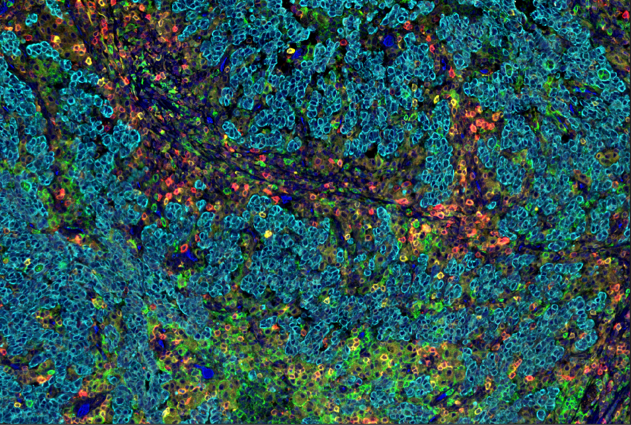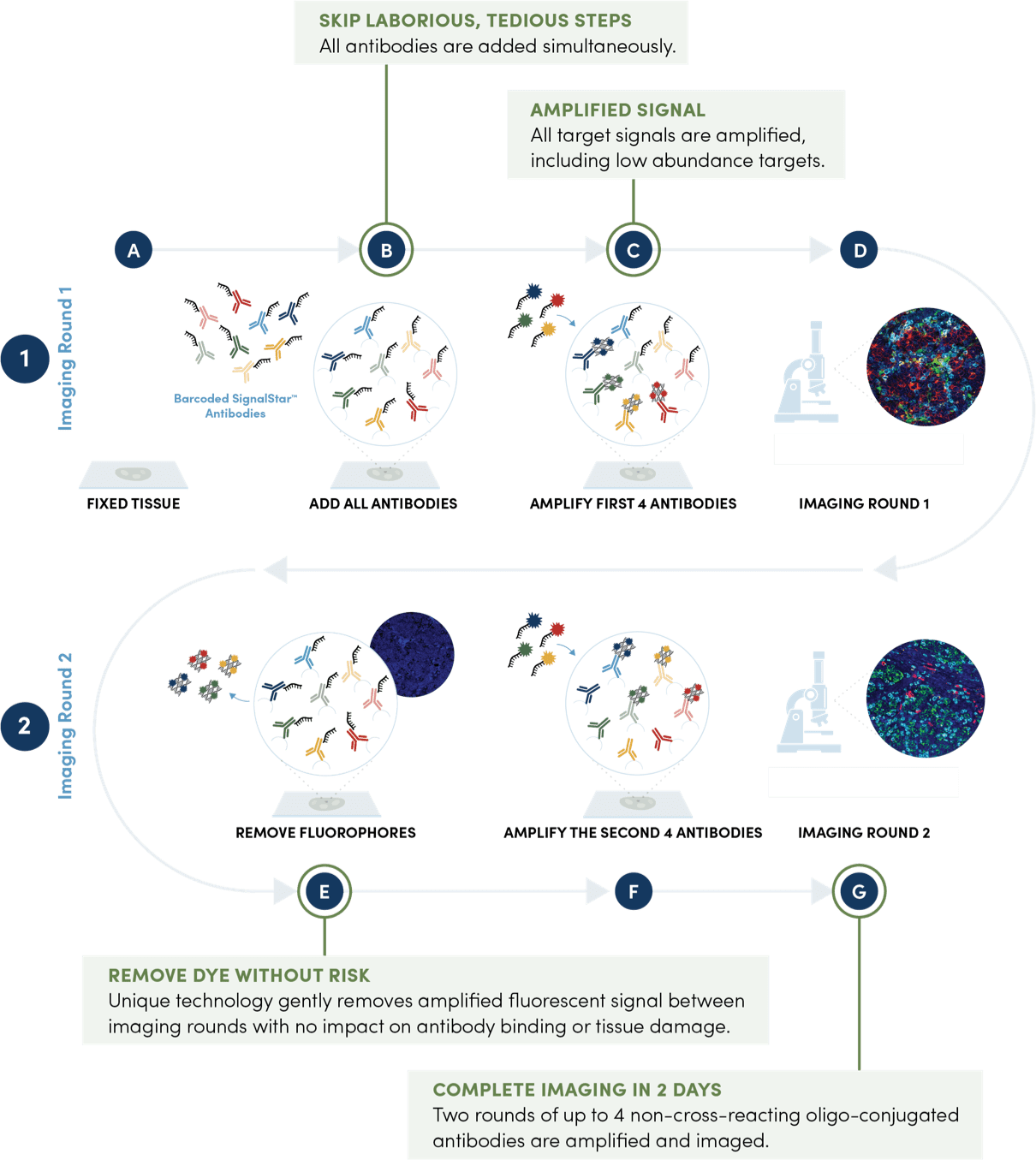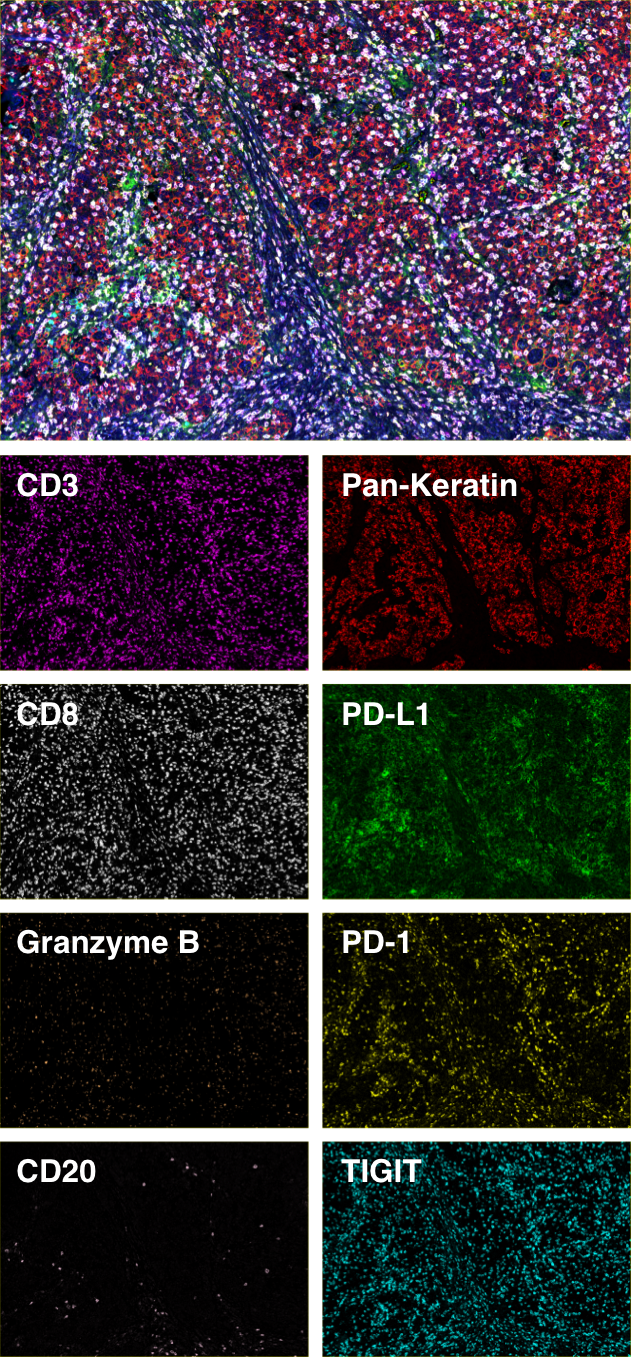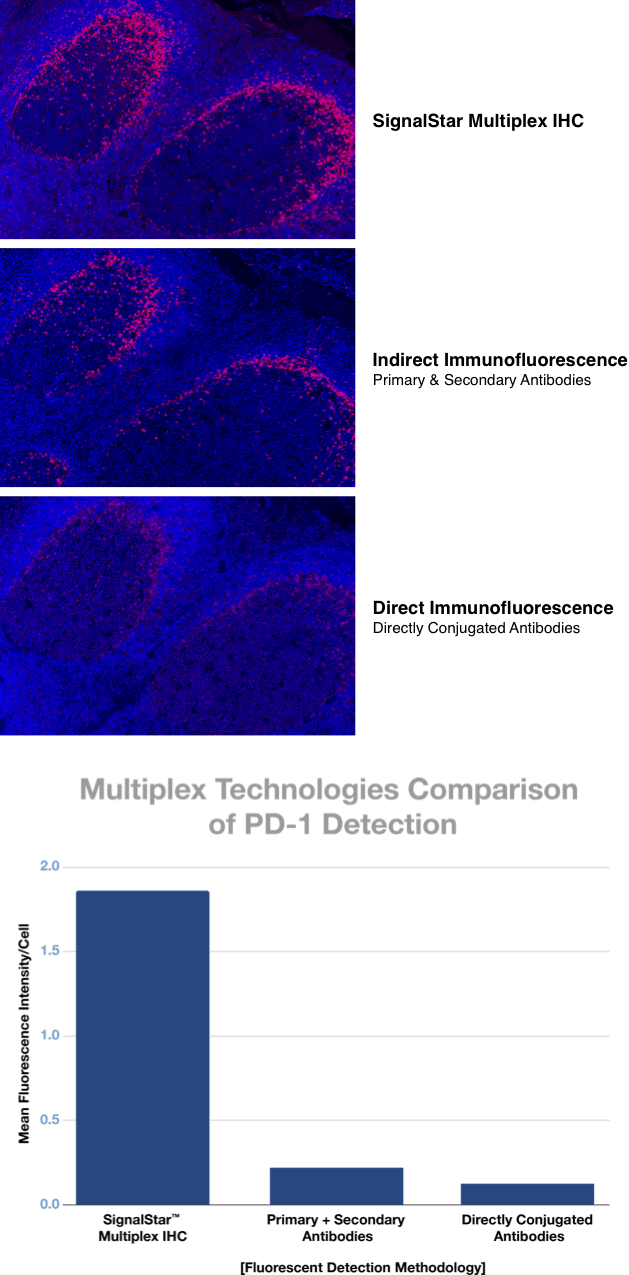
SignalStar Multiplex IHC from CST is a revolutionary new tool for spatial biology research, providing fully flexible and highly-validated antibody panels.
SignalStar technology amplifies multiple biomarkers simultaneously in FFPE tissue with high sensitivity and specificity. Accurate, reliable data can be generated on up to 8 targets in just 2 days.
Want to revolutionize your research? Create your panel today!
SignalStar Multiplex IHC is a technology that uses antibodies, oligonucleotides, and fluorophores to interrogate cellular presence, location, function, and biomarker co-expression patterns. SignalStar assays enable the detection of multiple phenotypic and functional targets while maintaining spatial context and tissue architecture. These insights are essential in understanding how cells organize and interact to influence the tissue microenvironment to drive disease progression and therapeutic responses.
Multiplex IHC (mIHC) is a versatile and powerful tool that can be used to answer a wide range of research questions. Whether you need to understand the native state of targets and cells, maximize data acquisition, understand cellular function, or detect proteins because RNA information is just not enough—multiplex IHC is the ideal solution.
Multiplex IHC enables the simultaneous detection of multiple protein and modification biomarkers within a single tissue sample, maintaining the original spatial and cellular context of targets and providing insights into the underlying function of cells and tissues.
Multiplex IHC lets you to maximize the amount of data acquired from an individual sample, reducing the need for additional tissue samples.
While RNA analysis can provide information about gene expression, it can't capture post-translational protein modifications such as phosphorylation, glycosylation, and acetylation. Multiplex IHC allows for the detection of multiple protein modifications simultaneously, providing a more comprehensive understanding of the underlying biology.

Figure Legend: The SignalStar assay allows for the simultaneous detection of up to 8 targets in formalin-fixed paraffin embedded (FFPE) tissue. Deparaffinized and rehydrated FFPE tissue sections undergo antigen retrieval (A), and all antibodies in your plex size of choice (3-8 maximum unique oligo-conjugated antibodies) are added in one primary incubation step (B). Complementary oligonucleotides with fluorescent dyes (channels: 488, 594, 647, 750 nm) amplify the signal of up to 4 oligo-conjugated antibodies in the first round of imaging by building large oligo branched structures off the antibody (C-D). If the plex size is greater than 4, the first round of oligonucleotides and fluorophores are gently removed (E), and a second round is added to amplify the signal of up to 4 additional oligo-conjugated antibodies (F). The two images are then aligned computationally with either proprietary or open-source software to generate the full up to 8-plex image (G).
Timelines for optimization and validation for other multiplex technologies can take weeks to months. SignalStar technology eliminates that time with optimized, ready-to-go panels. Select targets from a menu of IHC-validated antibodies that work out of the box in FFPE tissues.
Confidently analyze limited, precious FFPE tissue samples using highly-sensitive assays that give you the signal you need the first time. SignalStar assays enable you to amplify the fluorescent signal of up to 8 proteins in a single tissue.

Figure Legend: SignalStar multiplex immunohistochemical analysis of paraffin-embedded human gastric adenocarcinoma using Pan-Keratin (C11) & C0-0003-488 SignalStar Oligo-Antibody Pair #63566 (red), PD-L1 (E1L3N) & C0-0005-488 SignalStar Oligo-Antibody Pair #85646 (green), PD-1 (Intracellular Domain) (D4W2J) & C0-0008-594 SignalStar Oligo-Antibody Pair #35347 (yellow), Granzyme B (D6E9W) & C0-0009-594 SignalStar Oligo-Antibody Pair #15194 (orange), TIGIT (E5Y1W) & C0-0002-647 SignalStar Oligo-Antibody Pair #18288 (cyan), CD20 (E7B7T) & C0-0011-647 SignalStar Oligo-Antibody Pair #36775 (pink), CD3ε (D7A6E) Conjugate & C0-0001-750 SignalStar Oligo-Antibody Pair #51754 (magenta), CD8ɑ (D8A8Y) & C0-0004-750 SignalStar Oligo-Antibody Pair #62750 (white), and ProLong Gold Antifade Reagent with DAPI #8961 (blue). Representative individual and co-registered 8-plex images are included. All fluorophores were assigned a pseudocolor, as indicated. Staining was performed on the BOND RX autostainer by Leica Biosystems.
Many solutions lack the flexibility to evolve and adapt to changing research needs. SignalStar panels give you the flexibility to easily change targets and redesign panels as your needs change. Protocols are validated and optimized to work out of the box.
SignalStar technology stains consistently regardless of the panel you design in the SignalStar Multiplex IHC Panel Builder, and panels are ready to use out of the box. Protocols also demonstrate reproducibility across different antibody combinations, experiments, and imaging instruments.

Figure Legend:SignalStar multiplex immunohistochemical analysis of paraffin-embedded human medullary thyroid carcinoma within a tissue microarray. Panel 1: PD-L1 (E1L3N®) & C0-0005-647 SignalStar Oligo-Antibody Pair #52085 (yellow), PD-1 (Intracellular Domain) (D4W2J) & C0-0008-594 SignalStar Oligo-Antibody Pair #35347 (not shown), CD68 (D4B9C) & C0-0007-488 SignalStar Oligo-Antibody Pair #73071 (not shown), and CD3ε (D7A6E) & C0-0001-750 SignalStar Oligo-Antibody Pair #51754 (not shown). Panel 2: PD-L1 (E1L3N) & C0-0005-647 SignalStar Oligo-Antibody Pair #52085 (yellow), PD-1 (Intracellular Domain) (D4W2J) & C0-0008-594 SignalStar Oligo-Antibody Pair #35347 (not shown), CD68 (D4B9C) & C0-0007-488 SignalStar Oligo-Antibody Pair #73071 (not shown), and CD8 (D8A8Y) & C0-0004-750 SignalStar Oligo-Antibody Pair #62750 (not shown). Panel 3: PD-L1 (E1L3N) & C0-0005-647 SignalStar Oligo-Antibody Pair #52085 (yellow), PD-1 (Intracellular Domain) (D4W2J) & C0-0008-594 SignalStar Oligo-Antibody Pair #35347 (not shown), Ki-67 (8D5) & C0-0014-488 SignalStar Oligo-Antibody Pair #89034 (not shown), and CD8ɑ (D8A8Y) & C0-0004-750 SignalStar Oligo-Antibody Pair #62750 (not shown). All fluorophores were assigned a pseudocolor, as indicated. Staining was performed on the BOND RX autostainer. Percent positive PD-L1 cells were quantified in matched regions of interest from serial sections for three unique SignalStar 4-plex panels compared to single-plex SignalStar staining using PD-L1 (E1L3N) & C0-0005-647 SignalStar Oligo Antibody Pair #52085 (yellow) and chromogenic staining using PD-L1 (E1L3N) XP® Rabbit mAb #13684.
Unlike many other solutions, SignalStar panels offer amplification. SignalStar technology amplifies the signal from your targets, so that even low levels of expression are readily detectable. See more than you ever have before and detect targets with low levels of expression.

Figure Legend: SignalStar multiplex immunohistochemical analysis of paraffin-embedded human tonsil using PD-1 (Intracellular Domain) (D4W2J) & C0-0008-647 SignalStar Oligo-Antibody Pair #56837 (red) and ProLong Gold Antifade Reagent with DAPI #8961 (blue), compared to PD-1 (Intracellular Domain) (D4W2J) XP® Rabbit mAb #86163 detected with anti-rabbit IgG (H+L), F(ab')2 Fragment (Alexa Fluor® 647 Conjugate) #4414, and PD-1 (Intracellular Domain) (D4W2J) XP® Rabbit mAb (Alexa Fluor® 647 Conjugate). All fluorophores have been assigned a pseudocolor, as indicated. Staining was performed on the BOND RX autostainer. Mean fluorescence intensity of PD-1 positive cells was quantified in matched regions of interest from serial tissues sections for the SignalStar assay compared to the indirect and direct fluorescent methodologies.
We validate our antibodies in the SignalStar assay and guarantee them to work as expected. Every SignalStar antibody is validated against the chromogenic gold standard, and is consistently reproducible across replicates.
Our validation process begins with the IHC-P validation, followed by antibody validation for SignalStar Multiplex IHC.

Figure Legend: SignalStar multiplex immunohistochemical analysis of paraffin-embedded human colorectal adenocarcinoma using Pan-Keratin (C11) & C0-0003-488 SignalStar Oligo-Antibody Pair #63566 (green), PD-L1 (E1L3N®) & C0-0005-594 SignalStar Oligo-Antibody Pair #28249 (yellow), CD20 (E7B7T) & C0-0011-647 SignalStar Oligo-Antibody Pair #36775 (red), and CD8ɑ (D8A8Y) & C0-0004-750 SignalStar Oligo-Antibody Pair #62750 (cyan). Representative individual and 4-plex images are included. All fluorophores were assigned a pseudocolor, as indicated. Staining was performed on the BOND RX autostainer. Percent positive cells were quantified in matched regions of interest from serial sections for the SignalStar assay (n=2) compared to the chromogenic.
Stable fluorescent signals with distinct emission peaks make SignalStar panels compatible with your existing imaging instrumentation.
Image your slides using a microscope compatible with channels 488, 594, 647, and 750 nm to process 3-8 plex assays. With a 6-hour protocol run time, it's possible to stain and image a 4-plex in 1 day or an 8-plex in 2 days. The automated protocol enables overnight staining, greatly reducing hands-on time.
Every antibody used in a SignalStar panel has been independently validated for use in its intended application and guaranteed to perform as expected just like all CST® antibodies—to provide you with reliable, reproducible results, the first time and every time. You'll also be taking advantage of the most cited antibodies on the market.
Add all your antibodies at once without having to worry about epitope loss or masking.
Our online, easy-to-use SignalStar Multiplex IHC Panel Builder does the design work so you don't have to.